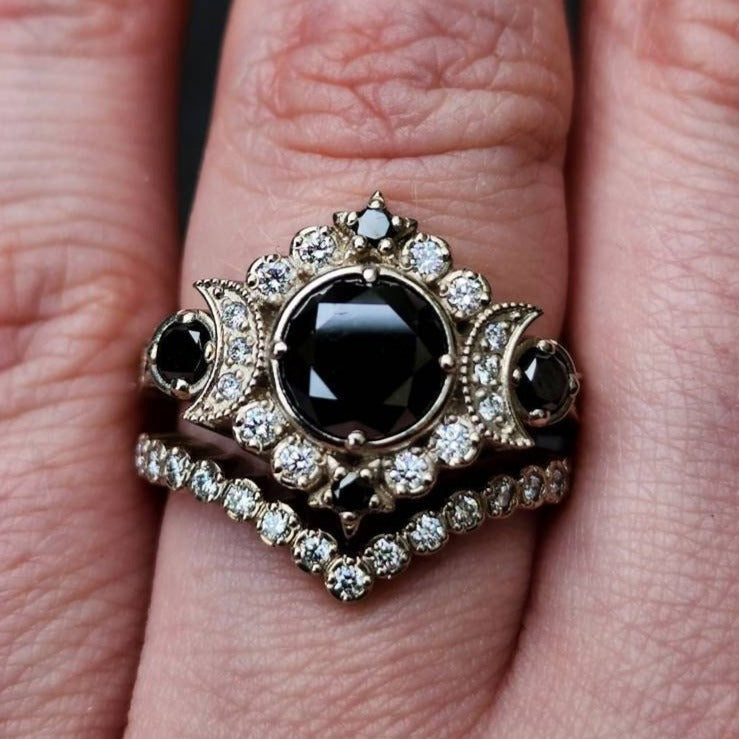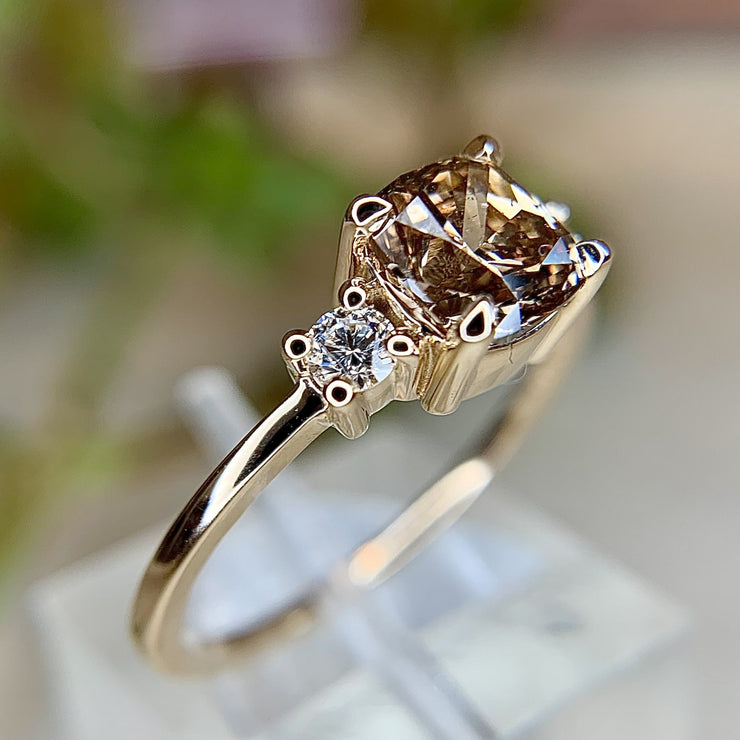lab grown diamond engagement rings and Sustainability: A Match Made in Heaven
Wiki Article
Comprehending the Advantages of Laboratory Grown Diamond Engagement Rings in Today's Market
Lab-grown Diamond interaction rings are ending up being increasingly preferred in today's market. These options to mined diamonds supply a variety of benefits that interest contemporary consumers. From ecological sustainability to cost financial savings, lab-grown diamonds present an engaging option. Their enhanced top quality and personalization options better contribute to their attraction. The expanding interest elevates questions regarding the implications of these selections. What elements should pairs think about when selecting lab-grown over conventional rubies?The Environmental Benefits of Lab-Grown Diamonds
As customers increasingly prioritize sustainability, lab-grown rubies emerge as a compelling choice to their mined counterparts. These artificial gems are produced in regulated environments, considerably minimizing the eco-friendly footprint connected with typical Diamond mining. The removal of natural diamonds often leads to habitat damage, dirt disintegration, and water pollution, devastating neighborhood communities. In comparison, lab-grown rubies need less land and water, lessening source deficiency.Furthermore, the energy used in the development of lab-grown diamonds can be sourced from sustainable energy, further decreasing their environmental impact. This process not only visuals carbon exhausts but additionally advertises lasting methods within the precious jewelry market. Customers that choose for lab-grown diamonds add to an extra moral and eco-friendly market, straightening their acquiring selections with their values. Generally, lab-grown diamonds offer a remedy that integrates luxury with ecological obligation, appealing to an expanding market concerned concerning sustainability.
Cost-Effectiveness of Lab-Grown Involvement Rings
While lots of couples look for to balance quality and spending plan when choosing engagement rings, lab-grown rubies provide an affordable alternative without jeopardizing on beauty or durability. Commonly valued 20-40% reduced than their natural equivalents, lab-grown diamonds permit couples to designate their budget extra flexibly, allowing bigger carat dimensions or higher high quality rocks for the exact same rate. This cost does not diminish the aesthetic charm; lab-grown rubies exhibit the very same brilliance and clearness as extracted diamonds, thanks to the same chemical and physical properties. Furthermore, the marketplace for lab-grown diamonds is expanding, leading to competitive prices and raised accessibility. Pairs can additionally delight in a broader variety of styles and settings without the monetary pressure often connected with standard diamonds. In general, lab-grown interaction rings offer an attractive financial option, making them progressively prominent amongst modern-day pairs that focus on both price and quality in their buying decisions.Honest Factors To Consider in Selecting Lab-Grown Diamonds

Customers are significantly worried about the origins of their purchases, and lab-grown rubies give a clear supply chain. Each Diamond comes with accreditation outlining its production procedure, making certain buyers can make educated options. The production of these diamonds typically uses sustainable energy sources, even more lining up with eco-conscious values. For individuals prioritizing moral intake, lab-grown rubies offer an accountable option that merges luxury with moral honesty, interesting modern-day sensibilities in interaction ring selections.

Quality and Elegance: Comparing Lab-Grown and Mined Diamonds
The comparison between lab-grown and extracted rubies discloses remarkable distinctions in aesthetic attributes and toughness. Lab-grown rubies commonly display exceptional clarity and color uniformity, while extracted diamonds can present unique incorporations and variants. Furthermore, both types share the very same firmness, making them similarly suitable for involvement rings.
Aesthetic Qualities Comparison
Just how do lab-grown diamonds compare to their extracted counterparts regarding aesthetic features? Both sorts of diamonds share identical physical and chemical buildings, making it challenging to identify between them without specialized devices. Lab-grown diamonds typically show fewer inclusions and imperfections, resulting in exceptional clearness. Additionally, they can be generated in a larger series of shades, enabling for one-of-a-kind modification options. While extracted diamonds are valued for their all-natural origin and viewed rarity, lab-grown rubies can achieve equal elegance and radiance, usually at a lower price. Ultimately, the option in between the two may boil down to individual preference, however aesthetically, lab-grown rubies stand as a compelling option, flaunting top quality that rivals their natural equivalents.Durability and Firmness Variables
While both lab-grown and extracted diamonds possess outstanding durability, their firmness stays a specifying particular that emphasizes their suitability for everyday wear. Diamonds are rated a 10 on the Mohs scale of mineral firmness, making them the hardest natural material understood (lab grown diamond engagement rings). This particular guarantees that both sorts of diamonds withstand scraping and preserve their sparkle with time. Lab-grown rubies, developed under regulated problems, display the exact same firmness and physical buildings as their extracted equivalents. Consequently, they use a resilient and attractive alternative for involvement rings. Customers can confidently select either type, knowing that both provide long-lasting high quality. Eventually, the option between lab-grown and extracted rubies may come down to individual values as opposed to distinctions in longevity or firmnessPersonalization Options for Lab-Grown Diamonds
Lab-grown diamonds supply a wide variety of customization options that deal with private preferences. From one-of-a-kind design opportunities to different color and cut options, these rubies can be customized to match any individual style. This level of customization guarantees that each involvement ring can show the news distinct preferences of the wearer.One-of-a-kind Style Opportunities
Many design opportunities await those thinking about lab-grown Diamond interaction rings, allowing pairs to express their special Discover More romance. With the adaptability of lab-grown diamonds, designers can discover a wide variety of styles, from traditional jewelry to elaborate vintage setups. Couples can select from numerous shapes, such as round, princess, or emerald cuts, each using a distinct character. In addition, the ability to choose one-of-a-kind metal types, consisting of white gold, climbed gold, or platinum, further improves modification. Lab-grown diamonds can likewise be fairly sourced in numerous carat weights, allowing couples to locate the excellent balance between size and budget plan. This versatility allows each ring to show the private preferences and choices of the couple, making it a truly personal sign of their commitment.Customization for every single Design
The versatility of lab-grown diamonds extends beyond distinct style opportunities, using considerable modification options to suit every pair's design. Pairs can select from numerous setups, steels, and band designs, assuring that their interaction ring shows their uniqueness. Choices range from traditional solitaires to modern halo designs, permitting individual expression in every selection. Furthermore, couples can select specific features such as inscription, including emotional value and uniqueness to their rings. The capacity to tailor assurances that each ring is not only a depiction of love yet likewise a reflection of personal preference and way of life. This level of customization makes lab-grown rubies an attractive choice for those looking for a distinctive and purposeful interaction ring.Color and Cut Selections
Interaction rings featuring lab-grown rubies provide a spectacular array of shade and cut choices that boost their appeal and originality. Unlike standard diamonds, lab-grown choices can be produced in an extensive series of colors, including pink, blue, and yellow, enabling pairs to choose an uniquely personal touch. These lively colors can act as a purposeful representation of love and dedication.Lab-grown diamonds come in different cuts, consisting of princess, oval, and round, each adding to the stone's radiance and aesthetic allure. This flexibility allows pairs to tailor their rings to reflect their styles and preferences. Inevitably, the availability of diverse color and cut options makes lab-grown Diamond interaction rings a preferred selection for modern couples seeking customization.
Patterns and Appeal of Lab-Grown Diamonds in 2023
As customers significantly focus on sustainability and moral considerations in their buying decisions, the popularity of lab-grown diamonds has surged in 2023. This year, the market has seen a noteworthy shift, with more couples choosing these diamonds due to their lower environmental influence and clear sourcing procedures. Lab-grown rubies are not only significantly much more affordable than their mined equivalents, yet they likewise use a variety of styles and personalization choices that attract modern consumers.Stores have actually reacted to this growing fad by increasing their collections and highlighting the distinct qualities of lab-grown rocks, such as their luster and clearness. Social media and influencer recommendations have actually even more amplified understanding, making lab-grown rubies a classy choice for interaction rings. As education concerning the advantages continues to spread out, it is anticipated that the marketplace share of lab-grown diamonds will certainly proceed to climb, solidifying their area in the fashion jewelry industry.
Regularly Asked Questions
Exactly How Are Lab-Grown Diamonds Developed in a Research laboratory?
Lab-grown diamonds are developed utilizing two main techniques: High Pressure Heat (HPHT) simulates natural Diamond development problems, while Chemical Vapor Deposition (CVD) uses gas to precipitate carbon onto a substratum, forming diamonds layer by layer.Do Lab-Grown Diamonds Hold Their Value With Time?
Lab-grown diamonds normally do not hold their worth as well as natural rubies. Market variations and consumer perceptions affect resale rates, causing reduced long-lasting worth retention for lab-grown alternatives compared to weblink their natural equivalents.Can Lab-Grown Diamonds Be Resized Like Mined Diamonds?
Lab-grown rubies can be resized likewise to extracted rubies, as they have equivalent physical properties. Jewelers generally employ common strategies for resizing, ensuring that both sorts of diamonds maintain their honesty and visual allure during the process.
Are Lab-Grown Diamonds Available in Various Forms and Sizes?
Lab-grown rubies are without a doubt available in a variety of dimensions and forms. They can be tailored to fulfill individual preferences, providing choices like round, princess, oval, and emerald cuts, to name a few, guaranteeing varied options for customers.Exactly how Do I Confirm the Authenticity of a Lab-Grown Diamond?
To validate the authenticity of a lab-grown Diamond, one ought to seek advice from a credible jeweler or acquire a qualification from a recognized grading laboratory, which typically consists of information concerning the Diamond's beginning and qualities.Lab-grown diamonds are developed in regulated settings, getting rid of the ecological destruction usually linked with typical Diamond mining. lab grown diamond engagement rings. Lab-grown diamonds often display exceptional clearness and color uniformity, while extracted rubies can offer distinct inclusions and variations. While extracted rubies are treasured for their natural origin and perceived rarity, lab-grown rubies can attain equal beauty and luster, commonly at a lower price. Lab-grown diamonds typically do not hold their value as well as all-natural diamonds. Lab-grown rubies can be resized likewise to mined rubies, as they have similar physical properties
Report this wiki page